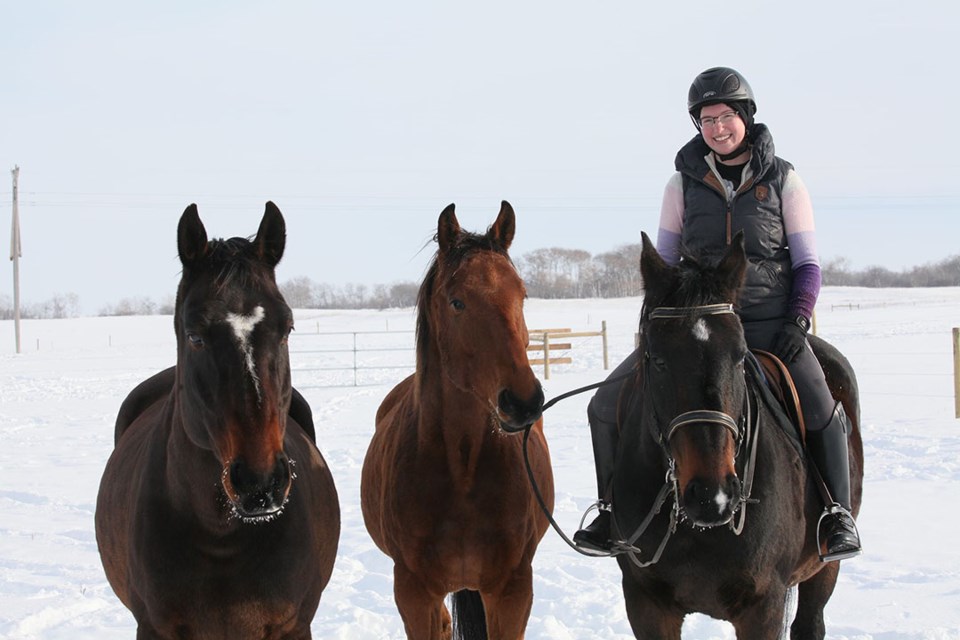SASKATOON — From the show-jumping arenas of her youth to the labs of the Western College of Veterinary Medicine (WCVM), Dr. Madison Ricard’s (DVM) passion for horses has driven her every step of the way in her academic career.
Now, the horse enthusiast is preparing to officially receive her PhD in anatomic pathology at the University of Saskatchewan (USask) Fall Convocation on Nov. 13.
Ricard’s , offering valuable insights that could help veterinarians better understand and address reproductive health issues in horses.
Ricard’s deep-rooted interest in horses led her to pursue a career in veterinary medicine, a journey that began at the University of Calgary where she received her Doctor of Veterinary Medicine (DVM) degree in 2020. Her next move was to Saskatoon where she began residency training in anatomic pathology while simultaneously working on her PhD program.
“Many of the anatomic and clinical pathologists I met during my time at University of Calgary Faculty of Veterinary Medicine graduated from WCVM and had fond memories of their time there,” said Ricard. “[USask] seemed like a natural fit.”
While Ricard knew she wanted to work with horses for her research, she was “open to anything” when it came to choosing a specific research topic. Her curiosity was sparked by a simple comment from Dr. Bruce Wobeser (DVM, PhD), her graduate supervisor in the WCVM’s Department of Veterinary Pathology.
“My supervisor came into the office one day and he said, ‘I don’t think we know anything about equine abortion in Canada.’ And that struck me—not only because it is pathology related, but also because it has that equine reproduction piece to it that I’ve always really enjoyed,” said Ricard.
Her research began with a retrospective review of previous studies on equine abortions, which led her to an eye-opening paper from Australia. The study, which at the time was relatively recent, revealed cases of Chlamydia psittaci (C. psittaci)—a bacterial pathogen typically associated with birds—causing equine abortions.
This unexpected finding intrigued Ricard.
“Based on that discovery in Australia, we thought, ‘Well maybe that’s happening here in North America, and we just aren’t seeing it,’” said Ricard.
The Australian scientists examined archived tissue from the previous 20 years and found 6.5 per cent of the samples tested were positive for Chlamydia—a much higher percentage than expected.
Taking inspiration from the Australian study, Ricard began to examine Canadian equine abortion cases to see if the link between Chlamydia and equine abortion was as strong at home. And to her surprise, it was.
Ricard and her team submitted 99 samples from equine abortions that occurred between 2009 and 2020 to Prairie Diagnostic Services, Saskatchewan’s veterinary diagnostic laboratory. Of those samples, 26 tested positive for Chlamydia. However, unlike the Australian findings, the samples her team submitted were identified as Chlamydia abortus (C. abortus)—another bacterial species that is more commonly linked with sheep and cattle.
“Chlamydia abortus is a rarely reported pathogen causing abortion in horses in Europe—we’re talking maybe one in 100 abortion cases,” said Ricard. “We found it at a much higher level. I maybe thought we would find one case and we ended up finding 26.”
Once the team had established the presence of Chlamydia in their samples, Ricard’s next step was to understand how the fetuses were becoming infected. To explore this, her team analyzed endometrial biopsies (samples from the lining of the equine uterus) to see if the infection was present in those tissues.
“We actually found [Chlamydia] in those tissues as well,” said Ricard. “That suggests that there is some sort of uterine infection with this pathogen, meaning it could be potentially treatable.”
Her findings also highlight a critical concern beyond equine health. C. abortus is a zoonotic pathogen, meaning it can be transmitted between animals and humans. As a result, it poses a risk to those handling infected tissues, including veterinarians and horse breeders.
“There is a risk if you’re handling aborted tissues from a mare that you could potentially acquire that pathogen yourself and become quite ill,” said Ricard, emphasizing the importance of personal protective equipment for anyone handling aborted equine tissues.
Ricard also explored non-infectious causes of equine abortion, including umbilical cord twisting and its impact on foals during their first 30 days of life. These investigations contributed to a more comprehensive view of the factors affecting equine reproductive health.
Overall, Ricard’s research has helped to create more awareness among horse owners and breeders. It’s also opened the door to new investigations in veterinary pathology.
“Almost all of the studies I did are setting up for future research,” said Ricard. “I would really like to see that research get picked up and carried forward.”
In August, Ricard’s journey came full circle when she joined the WCVM faculty as a lecturer in the college’s Department of Veterinary Biomedical Sciences.
“I think deep down somewhere in my soul I have always been a teacher,” said Ricard, whose role includes teaching anatomy and histology to veterinary students.
“I’ve spent a lot of time studying these topics the last four years. Now, being able to share that information with other people is very gratifying.”
— Submitted by USask Media Relations




